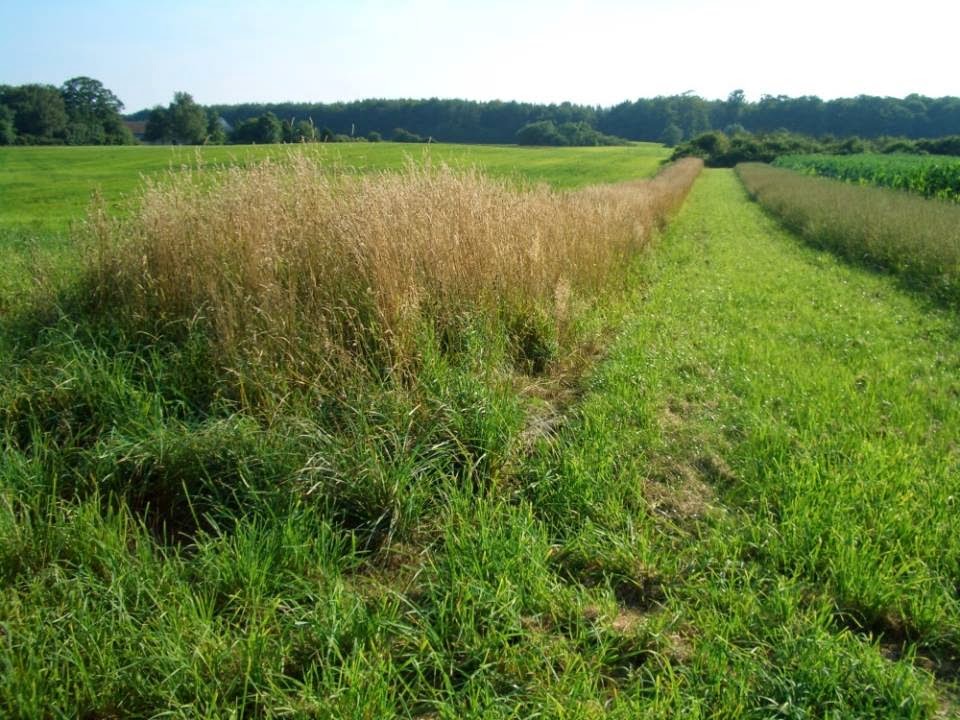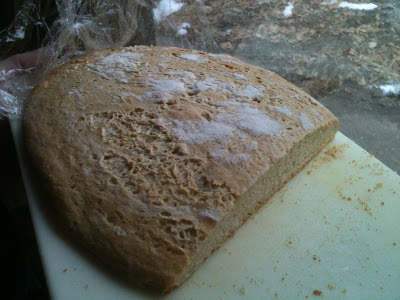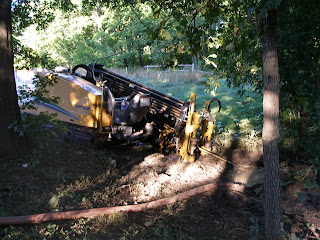Beneficial Habitat: Beetle Banks
 |
| Ground Beetle |
This technique is also important in the ecological design of food production areas on homestead or in a production orchard. Many times we think of beneficial habitat for the use of pollinators and flying insects. We need to remember that there is a great diversity of beneficial insects that need habitat. Beetles play an important role in controlling past populations in our growing spaces.
Beetle Banks, suggested by Southerton (1984) are grassy ridges within crop fields, which by their position, decrease the travel distance of flying or crawling beneficial insects. Field edges of rough Tussock grass covered banks (Luff 1966) support a high density population of Caribidae ( Large Ground Beetles) and Staphylinidae (Smaller Rove Beetles) (Thomas 1991).
 |
| Rove Beetle |
According
to Collins et al. (2003), the most needed Integrated Crop Management (ICM)
component is natural biocontrol agents (BCA). The most important BCAs in Cereal aphid control are polyphagous (predators of multiple prey, not specific) arthropods. Since
expanded agricultural intensification has removed or degraded field boundary
areas, added habitat spaces are needed for increased polyphagous predator benefit.
Field edges of rough Tussock
grass covered banks (Luff 1966) support a high density population of Caribidae
and Staphylinidae (Thomas 1991). Beetle Banks, suggested by Southerton
(1984) are grassy ridges within crop fields, which by their position, decrease
the travel distance of beneficial insects, flying or crawling. Reducing
the distance from edge to edge increases the frequency and duration of
beneficial insects in the central areas of the growing space.
Function
of Beetle BanksThe function of the beetle banks is to increase supportive habitat for conservation biocontrol, reduce stress on predators of crop pests, and the travel time from over wintering habitat to field center. The over-wintering refuges (Beetle banks) are placed mid field and allowed to regenerate foliage from seed and natural sources. Colonization by local plant, animal, and insect genera may take time to disperse from existing habitat. Transfers from previous spaces are affected by soil, distance and quality of field margins, and insecticide used in field areas. Generally, banks are seeded and left to natural species movement (Collins et al. 2003). From all studies reviewed, none inoculated the beetle banks with field margin soils or plants. Barren strips were seeded and started without the trophic system existing in the unplowed habitat of field edges. Using the comparison of the field margins as the banks mature gives a good baseline for the progress of the monitored insects. In practice it may be better to transplant dormant grasses and soils from the margins into the banks to inoculate and accelerate the banks succession
Key design considerations
• Provide plant diversity and structure in the buffer.
• Protect buffer from disturbances (e.g., pesticides,
tillage).
• Predation of insect pests generally increases with the
percentage of buffer habitat in the area.
 |
US Forest Service 1400 Independence Ave., SW
Washington, D.C. 20250-0003
|
• Locate buffers throughout the fields and landscape to
encourage dispersal of beneficial insects.
• Buffers may provide habitat for some pest insects but
this can be reduced by selecting appropriate plants Beetle banks are long,
planted berms that provide habitat for beneficial insects.
The Goal
- The manipulated habitat increases the population of beneficial insects
- Beneficial arthropods move from the enhanced habitat to have an area of agricultural value
- The beneficial arthropods established and/or remain in growing space long enough to provide an significant impact on the pests for increased harvest (from Loughner R. et al, 2010)
Do beetle banks do this?
Can the habitat enrichment increase PCs enrichment and
the supporting trophic levels to sustain an ecological and best economic
benefit?
Design and Installation
•With farm equipment, the bank is created by careful two-direction plowing, with furrows plowed against each other, during autumn cultivation.•Machine drill or hand sow with a mixture of perennial grasses including at least 30% tussock-and mat-forming species (in the UK, these include orchard grass (Dactylisglomerata) and Timothy grass). •The rest of the mixture can consist of fescues and bents.
•For good establishment these can be sown at a rate of 70 kg/ha (62 lbs./acre).
•Three mowing cuts may be necessary in the first year (when the sward reaches 10cm) to encourage grasses to tiller and control invasive annual weeds.
•Once established, cuts are needed only to encourage dead tussocks to regenerate, and to control woody species (approx. once in three years).
•Being within the field, beetle banks are particularly susceptible to pesticide drift.
 Beetle banks differ in soil and shape from field to
field.
Beetle banks differ in soil and shape from field to
field.
In North Hampshire, U.K., Thomas , et al (1991) used "raised Earth banks' (above) .4
meters high x 1.5 meters wide. Bi-directional plowing created a bank 290 meters
long across two fields. The bank ends were spaced 20 - 50 meters from the field
edges. Herbicide was used to clear the resulting plowing weeds and seed was
broadcast.
 |
| Click for PDF |
Grasses included:
- DactylisglomerataL.(Cock's Foot)
- Loliumperenne L. (a perennial rye-grass)
- Agrostisstolonifera L. (creeping bent)
- Holcuslanatus L. (Yorkshire- fog)
In most studies a bare soil bank and single species bank was also used as a
control. These are common U.K. grasses, not considered invasive.
Again an earth ridge was established by plow and then hand sown with D. glomerata.
Collins 2003 established similar banks for overwintering data. Most banks being 2-5 meters wide and a relative height. Frankl 2004, a Swiss study, did not use beetle banks but wild flower overwintering sites for beetles. I thought this was an interesting facet to the the foliage options for beetle banks. The banks in most studies were fairly narrow and rounded to a small rise above the field. The need for burrowing by the overwintering beetles requires a depth of uncompacted soil; protected space with rooting grasses supplies this habitat.
- McLeod 2004 duplicated the same bank structure for a seven year study.
- Collins 2003 in a 5 year over wintering study made larger banks .5 meters high and 2.5 meters wide. These were 400 m long with small pass though gaps for machinery at the ends.
- A later Thomas study 2002 looked at botanical diversity with banks spanning 13 years. These 1 to 13 year old banks were anywhere from 300 to 900m long and 2 to 5 m wide.
Again an earth ridge was established by plow and then hand sown with D. glomerata.
Collins 2003 established similar banks for overwintering data. Most banks being 2-5 meters wide and a relative height. Frankl 2004, a Swiss study, did not use beetle banks but wild flower overwintering sites for beetles. I thought this was an interesting facet to the the foliage options for beetle banks. The banks in most studies were fairly narrow and rounded to a small rise above the field. The need for burrowing by the overwintering beetles requires a depth of uncompacted soil; protected space with rooting grasses supplies this habitat.
High densities of predators is attributed to the
environmental buffering of tussock grasses and the lower variability in
temperature. A less variable temperature decreased insect mortality (Desender 2002). The thick dried grass and deepening thatch provides increased insulation in summer and winter. Many insects can make their way deeper into the soil along the plant stems and roots.
 Relative to diversity, field margins held more than twice
the nectary plants and 12 to 33 times the woody plants throughout the Thomas
2002 study.
Relative to diversity, field margins held more than twice
the nectary plants and 12 to 33 times the woody plants throughout the Thomas
2002 study.Grass Progression
Beetle bank
establishment takes about three years resulting in a broad dispersion of
predators across the field. Predator population increased to 1,600 per m2 in
some banks (Thomas et al,1992).
A number of grasses have been used and rated for their capacity in supporting large numbers of predators. Tall clumping grasses with fibrous roots were preferred. Increased ecological services of the beetle banks should not be overlooked.
Grasses used in a Beetle Bank must have suitable root types for burrowing beetles to over winter. Tussock grasses are more drought tolerant with deeper fibrous roots. Tussock grasses also control erosion and grow in clumps as opposed to carpet-like turf (Mcleod et al. 2004).
The dense grasses also protect the insects in wind and rain. Tussocky grasses were found to be the optimal vegetation for arthropod species for protection in cold and rainy weather (Thomas et al. 2002).
High densities of predators is attributed to the environmental buffering of tussock grasses and the lower variabilities in temperature. A less variable temperature decreased insect mortality (Desender 2002). Furthermore, establishing the tall grass species increased immediate microclimate effects and habitat in deference to matting grasses. The ridges by Thomas are suggested to have been nuclei of beetle dispersion allowing for even distribution of beetles such as Demetrias atricapillus through out the fields (Thomas 1991 ).
Thomas 2002 recorded 82 plant species in beetle banks and 89 in selected field margins, however coverage of the two differed in species. 55% more tussock grasses appeared on beetle banks compared to filed margins which held more than twice the nectary plants and 12 to 33 times the woody plants throughout the study. Succession to woody plants would take a few years if allowed by field maintenance.
Newly constructed and seeded banks showed high diversity of species the first year, but diversity declined as competition with the grasses selected out the weed seeds plowed up during construction. Gradual invasion by woody species would eventually develop the composition similar to hedgerows of the field margin (Thomas 2002). Caribidae populations would remain unaffected is grasses are not limited by vegetative diversity.
Grass
Habitat Density of Beetles
During all seven winters, spring-breeding Carabidae dominated all species on the bank to 94% (MacLeod et al, 2004).
Dominant Grasses:
D. glomerata (DG)
BCA insects overwintering in the beetle banks have the greatest effect on late season aphid populations by having high predator : prey ratios in the Spring (Macleod, et al, 2004). Flying beetles such as Staphylinidae can cross large spaces, but many Carabidae must crawl the distance.
Benefits of Polyphagous Predation
Aphids are insufficient for Polyphagous diet
Intra-competition and density dependence of the predators may well work within the beetle bank system, as populations of predators grow they must forage outside the bank into the field for an alternative food source and for some that will be aphids (Collins et al 2003).
Benefits of Polyphagous Predation
Aphids are insufficient for Polyphagous diet
Intra-competition and density dependence of the predators may well work within the beetle bank system, as populations of predators grow they must forage outside the bank into the field for an alternative food source and for some that will be aphids (Collins et al 2003).
Seasonal Effects
Collins (2002) identified two types of important Carabidae habits
- Those that over-winter in the grassy margins those that stay mid-field during winter.
- Aphid S. avenae over-winter within the fall wheat crop and are present on the plants in spring.
- Caribs over-wintering in wheat fields are not subject to spring plowing, but most seek winter habitat in margins.
Mean daily consumption increased with increasing temperature for both species, B. lampros consuming a maximum of 16 1–3 instar nymphs and 9 apterous adult aphids at 25 °C.
P. cupreus was particularly voracious and consumed 125 apterous adult R. padi per day at 20 °C.
The behavior of both species was analyzed by video filming starved beetles, maintained at different constant temperatures, in arenas sown with spring barley.
The behavioral components:
- stillness
- run/walk
- search
- confrontation
were identified and were common to both species. Searching behaviour and cereal aphid consumption by Bembidion lampros and Pterostichus cupreus, in relation to temperature and prey density
Carabidae in Habitat
The Carabids had a respective preference for Orchard Grass, Velvet Grass, and Creeping Bent Grass for overwintering, seemingly occupying the species till filled.
Conclusion
The bank is a base of resources available to the local fauna. These non-target benefits include nesting space for birds and small vertebrates, foraging space for Skylarks (Murray et al, 2002) and a safe haven from field sprays. Wind erosion is also decreased while adding farmland biodiversity. It should be noted that with the focus on grasses for BCA habitat, fewer nectar source plants are available in beetle banks compared to field margins (Thomas, 2002). Individual plant species were not exclusive to either space, yet opportunity for flowering plants is better on the more diverse field margins. Species richness is lower due to the limited initial seed diversity used.
Beetle banks create beneficial habitat for biological control agents important to pest management. Since the effect of predation from the bank is passive and seasonally variable it is a strategy best used as part of an overall system of pest management. Increased and diverse habitat in and around crop fields can only increase the benefit of natural enemies. Reducing field margins and depleting available ecological services is counter to good agricultural practices. Vegetated field strips for beneficial habitat such as beetle banks have a multi-layered benefit for farm, field, and finances.
-Daniel Halsey
Conclusion
The bank is a base of resources available to the local fauna. These non-target benefits include nesting space for birds and small vertebrates, foraging space for Skylarks (Murray et al, 2002) and a safe haven from field sprays. Wind erosion is also decreased while adding farmland biodiversity. It should be noted that with the focus on grasses for BCA habitat, fewer nectar source plants are available in beetle banks compared to field margins (Thomas, 2002). Individual plant species were not exclusive to either space, yet opportunity for flowering plants is better on the more diverse field margins. Species richness is lower due to the limited initial seed diversity used.
Beetle banks create beneficial habitat for biological control agents important to pest management. Since the effect of predation from the bank is passive and seasonally variable it is a strategy best used as part of an overall system of pest management. Increased and diverse habitat in and around crop fields can only increase the benefit of natural enemies. Reducing field margins and depleting available ecological services is counter to good agricultural practices. Vegetated field strips for beneficial habitat such as beetle banks have a multi-layered benefit for farm, field, and finances.
-Daniel Halsey
A Major Beetle Bank Player
The staphylinid beetle Tachyporus hypnorum
Aphid Predation of T. hypnorum
Based on gut contents relative to filed density of pest aphids, T. hypnorum ranked fourth as an aphid predator of 18 epigeal coleopteran predators (Sunderland & Vickermanm, (1980).
Aphid Predation of T. hypnorum
Based on gut contents relative to filed density of pest aphids, T. hypnorum ranked fourth as an aphid predator of 18 epigeal coleopteran predators (Sunderland & Vickermanm, (1980).
Other Characteristics:
- High prey consumption rate
- High response to prey spatial heterogeneity
- Foraging on plants in preference to the soil surface. (Wratten, Bryan et al,1984)
- A strong aggregative response to aphid aggregations of adult and larvae in cereal fields.(Bryan & Wratten 1984).
- Densities were 2.3 and 3.3 times higher, respectively, than those in control areas of very low aphid density.
- Post-overwintering adults consume a maximum of 1 mg/day of aphid biomass at 20ºC, representing 34% of mean adult bodyweight.
- Type 3’ functional response (Holling,1965) for T. hypnorum and its aphid prey, showing the potential of this species at least to cause density-dependent mortality of its aphid prey (Vickerman, Dowie & Playle (1988).
Citations:
5-year comparison of overwintering polyphagous
predator densities within a
beetle
bank and two conventional hedgebanks
By K L Collins, N D
Boatman, A Wilcox, and J M Holland
Feeding behaviour of the staphylinid beetle Tachyporus hypnorum in relation to its potential for reducing aphid numbers in wheat By p. Dennis, s. D. Wratten and n. W. Sotherton* 1990
Creation of 'island' habitats in farmland to manipulate populations of beneficial arthropods: predator densities and emigration by m.b. Thomas*, s.d. Wratten* 1991
The timing of dispersal of the predatory beetles Bembidion lampros and Tachyporus hypnorum from hibernating sites into arable fields Mette K. Petersen 1999
Habitat selection in the carabidae w. G. Evans 1983
‘Beetle banks’ as refuges for beneficial arthropods in farmland: long-term changes in predator communities and habitat MacLeod*, S. D. Wratten*�, N. W. Sotherton� and M. B. Thomas*ァ 2004
‘Beetle banks’ as refuges for beneficial arthropods in farmland: long-term changes in predator communities and habitat MacLeod*, S. D. Wratten*�, N. W. Sotherton� and M. B. Thomas*ァ 2004
Botanical diversity of beetle banks. Effects of age and comparison with conventional arable field margins in southern UK Susan R. Thomasa,b,∗, Rienk Noordhuis b, John M. Holland a, Dave Goulson b 2002
Influence of beetle banks on cereal aphid predation in winter wheat K.L. Collins a,∗, N.D. Boatmanb,1, A. Wilcox a, J.M. Holland c, K. Chaney a 2002
Effects of different grass treatments used to create over wintering habitat for predatory arthropods on arable farmland K.L. Collins a,∗,1, N.D. Boatmanb,2, A. Wilcox a, J.M. Holland c 2003
Staphylinidae and Carabidae overwintering in wheat and sown wildflower areas of different age T. Frank* and B. Reichhart 2004
Staphylinidae and Carabidae overwintering in wheat and sown wildflower areas of different age T. Frank* and B. Reichhart 2004
Influence of leaf trichomes on predatory mite density and distribution in plant assemblages and implications for biological control R. Loughner *, K. Wentworth, G. Loeb, J. Nyrop 2010












Comments
http://www.google.com/url?sa=t&rct=j&q=&esrc=s&source=web&cd=9&ved=0CEIQFjAI&url=http%3A%2F%2Foregonipm.ippc.orst.edu%2FAgroecology%2FNEW_BEETLE_BANK_1.pdf&ei=pBSkVJe1Fs2xogTl8YKIDg&usg=AFQjCNEenHHnuxOrd3YBdX84mJpI6XsHaQ&sig2=GoZ_DmAEcEFMkr3qeF1XnQ